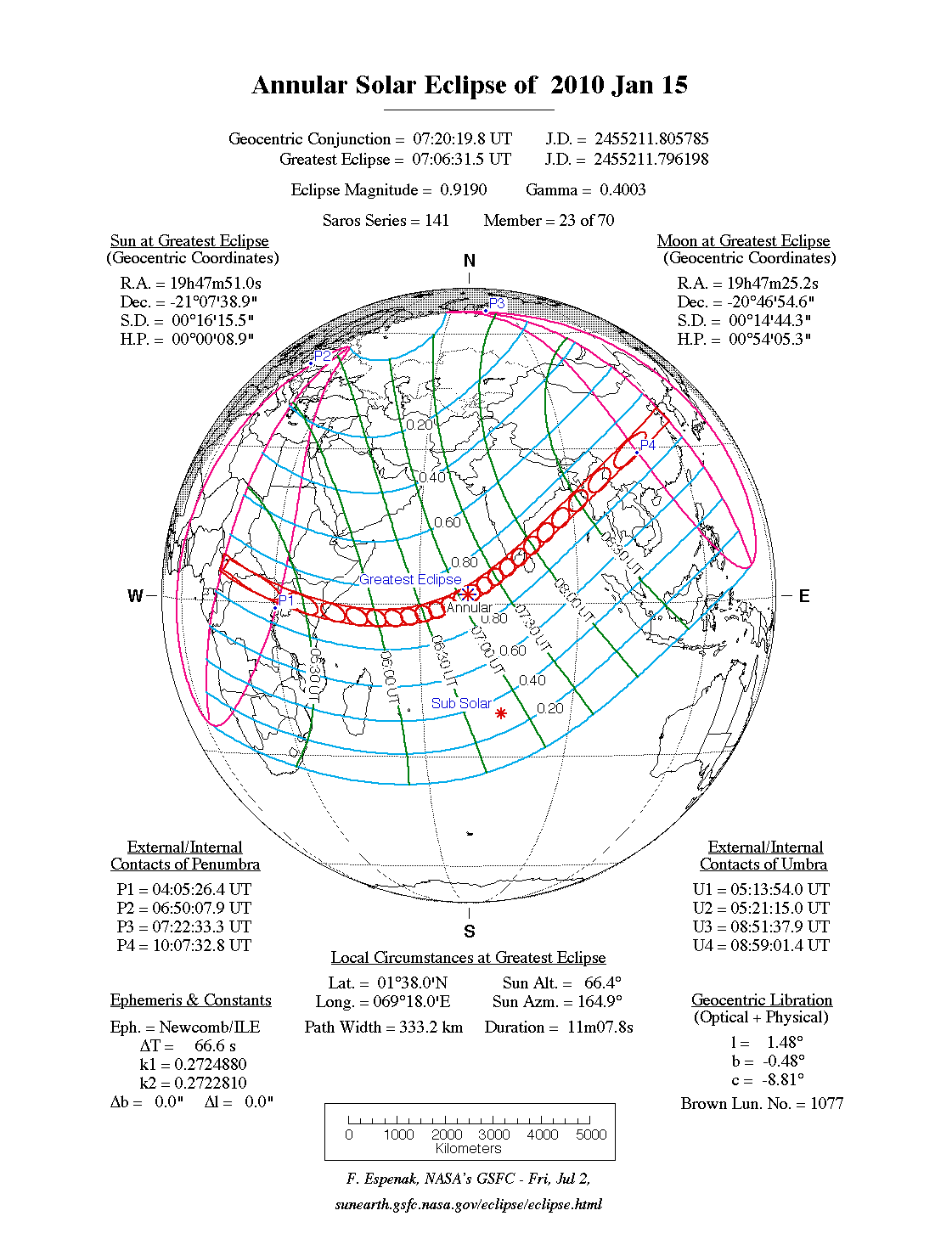An annular eclipse of the Sun occurred on Friday 15 January, 2010 UT, lasting from 04:05–10:07 UT. A small annular eclipse covered only 92% of the Sun in a very broad path, 333 km wide at maximum, and lasted 11 minutes and 8 seconds. It was visible from central Africa, across the Indian Ocean, the southern tip of India, and into China. The partial eclipse was visible in eastern Africa, the Middle East, and south and east Asia.
The timings of the phases of the overall eclipse
worldwide are as follows. In any particular
place it would have been seen for a significantly shorter
duration as the shadow moved across the Earth:
| Partial eclipse began: |
04:05:26 UT |
| Annular eclipse began: |
05:13:54 UT |
| Maximum eclipse: |
07:06:31 UT |
| Annular eclipse ended: |
08:59:01 UT |
| Partial eclipse ended: |
10:07:33 UT |
During this eclipse the Sun was 0.542° in apparent
diameter, 1.7% larger than average. The Moon was just 2 days before apogee, making it very small.
At maximum eclipse it was 0.498° in
apparent diameter, which is 6.2% smaller than average; this was not
large enough to cover the Sun, which is why this
was an annular eclipse.
The statistics page has information on the ranges of the sizes of
the Sun and Moon, and the Moon data page displays detailed
information on the Moon's key dates.
The annular eclipse began over the Central African Republic, then crossed DR Congo, Uganda, Kenya, and the southern end of Somalia. It passed over some of the nortern islets of the Seychelles, then the Maldives. The annular eclipse track passed between India and Sri Lanka, being visible from both countries; then crossed the Bay of Bengal to Myanmar (Burma), being visible also from Bangladesh. It finally passed into China, crossed the country, and finished at the coast of the East China Sea.
Interactive Map
This map shows the visibility of the eclipse.
The shaded area saw the annular solar eclipse; however, near the edges of
this area, the eclipse was very short. The bold line shows the centre
of the path, where the eclipse lasted longest.
Use the zoom controls to zoom in and out; hover your mouse over any
point on the centreline to see the time and
duration of the eclipse at that point. You can pan and zoom the map to
see detail for any part of the eclipse path.
The interactive map is currently not available.
Overview Map
This map sourced from NASA Goddard Space flight Center: GSFC Eclipse Web SiteGSFC Eclipse Web Site
The primary source of all the information on eclipses presented here at Hermit Eclipse. (NASA Goddard Space flight Center)
shows the visibility of the annular solar eclipse. It also shows the broader area in which a partial eclipse was seen. (Click on it for the
full-sized version.)
Eclipse Season and Saros Series
This eclipse season contains 2 eclipses:
This was the 23rd eclipse in solar Saros series 141.The surrounding eclipses in this Saros series are:
This Saros series, solar Saros series 141,
is linked to lunar Saros series 134. The
nearest partner eclipses in that series are:
Eclipse Parameters
| UT Date/time (max) | 07:06:32 on 15 Jan UT |
TDT Date/time (max) | 07:07:39 on 15 Jan TDT |
| Saros Series | 141 |
Number in Series | 23 |
| Penumbral Magnitiude | |
Central Magnitiude | 0.919 |
| Gamma | 0.4002 |
Path Width (km) | 333 |
| Delta T | 1m07s |
Error | ± 0m01s (95%) |
| Penumbral Duration | |
Partial Duration | |
| Total Duration | 11m08s |
| |
| Partial Rating | |
Total Rating | |
| Sun Distance | 147157587 km (1.3%) |
Moon Distance | 405389 km (97.4%) |
| Sun Diameter | 0.542° |
Moon Diameter | 0.491° - 0.498° |
| Perigee | 20:36 on 1 Jan UT |
Apogee | 01:40 on 17 Jan UT |
| Contact p1 | 04:05:26 on 15 Jan UT |
Contact p2 | |
| Contact u1 | 05:13:54 on 15 Jan UT |
Contact u2 | 05:21:15 on 15 Jan UT |
| Max eclipse | 07:06:31 on 15 Jan UT |
| Contact u3 | 08:51:38 on 15 Jan UT |
Contact u4 | 08:59:01 on 15 Jan UT |
| Contact p3 | |
Contact p4 | 10:07:33 on 15 Jan UT |
Note that while all dates and times on this site (except
where noted) are in UT, which is within a second of civil time,
the dates and times shown in NASA's eclipse listingsGSFC Eclipse Web Site
The primary source of all the information on eclipses presented here at Hermit Eclipse. (NASA Goddard Space flight Center)
are in the TDT timescale.
The Sun and Moon distances are shown in km, and as a
percentage of their minimum - maximum distances; hence 0%
is the closest possible (Earth's perihelion, or the
Moon's closest possible perigee) and 100% is
the farthest (aphelion, the farthest apogee).
The statistics page has information on the ranges of sizes
of the Sun and Moon, and the Moon data page displays detailed
information on the Moon's key dates.
Data last updated: 2015-06-21 22:11:46 UTC.

